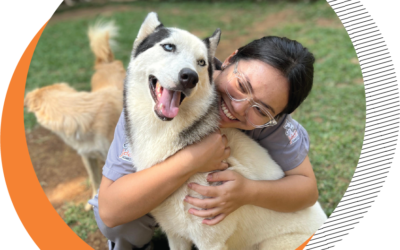
Tips for Traveling with Pets: Essential Preparations You Must Make
By: drh. Mikeu Paujiah & Maryam, S. Kom
Homecoming trips (mudik) are eagerly anticipated by many, especially during long holidays or festive seasons. However, for pet owners, traveling with their beloved pets can be a challenge.
Whether you decide to leave your pet at home or take them along, proper preparation is essential to ensure a smooth and safe journey. This article will cover important tips to make traveling with pets hassle-free.
Preparations Before Traveling
Before setting off, here are some key steps to ensure your pet remains healthy and comfortable throughout the journey:
- Check Your Pet’s Health Make sure your pet is in good health before embarking on a long trip. Take them to the vet for a health check-up, vaccinations, and consultations if needed. If your pet has a medical condition, ask the vet for guidance on how to manage it during the trip.
- Prepare a Comfortable Crate or Carrier If you’re bringing your pet along, use a crate or carrier that suits their size. Ensure it has proper ventilation and enough space for them to move around.
- Train Your Pet to Get Used to the Carrier If your pet isn’t used to a carrier, start training them a few weeks before the trip. Let them enter the carrier to sleep or eat so they feel comfortable and stress-free during travel.
- Pack Essential Supplies Some essential items to bring include:
-
Your pet’s favorite food and treats
-
Sufficient drinking water
-
A bedding pad or litter box for cats
-
Their favorite toys to keep them calm
-
Medications if needed
-
Wet wipes and plastic bags for cleanliness
-
Read Also : HOW TO TRAVELING WITH YOUR PET
Traveling Options: Bring Your Pet or Find a Sitter?
If you’re unsure whether to take your pet along or leave them behind, consider the following factors:
- Taking Your Pet Along If your pet is comfortable traveling and your destination allows pets, bringing them can be the best option. Ensure the place is pet-friendly and has adequate facilities.
- Finding a Pet Sitter If the journey is too long or your destination isn’t suitable for pets, leaving your pet behind might be a better choice. Here are some options:
-
Pet Hotel: Choose a reputable pet hotel with good facilities.
-
Leaving Your Pet with Family or Friends: If someone you trust can care for your pet, this can be a comfortable solution.
-
Pet Sitter Services: A pet sitter can visit your home regularly to feed and care for your pet.
-
No Hassle, As Long as You Prepare Well!
Traveling with a pet requires extra preparation, but with the right steps, the journey can be smooth and stress-free. Make sure your pet is in good health, prepare a comfortable carrier, and train them beforehand. Don’t forget to bring essential supplies like food, water, and their favorite toys.
If the journey is too long or the destination isn’t pet-friendly, consider a reliable pet-sitting option. With careful planning, you can travel worry-free while ensuring your pet’s well-being. Want more tips on pet care? Keep exploring and learning the best ways to take care of your furry friends!
Reference :
Traveling with your dog or cat. (n.d.). American Veterinary Medical Association. Retrieved March 25, 2025, from https://www.avma.org/resources-tools/pet-owners/petcare/cvi/traveling-your-dog-or-cat
Related Post
When Children Abuse Animals: Danger Signals to Watch Out For
By: Drh. Mikeu Paujiah, Dipl. Montessori and Maryam Smeer, S. Kom Translator : AWI TeamBeing aware of child abuse to animals is very important. This is because not only is it bad for the animal, but it can also be an indication of more serious problems in the child's...
4 Easy Ways to Find Out a Kitten’s Age
By: Drh. Mikeu Paujiah And Maryam Smeer Translator : AWI TeamBaby kittens' eyes will be closed when they are born. Their eyes will start to open at around 8-12 days of age. Kittens' eyes will be fully open by the time they are 2 weeks old.Read Also : Tips for Feeding...
Healthy Pets, Happy Families: Tips for Taking Care of Pets in the Transitional Season
By: Arditya Laksono - Freelance English Tutor The transitional season, or the period between seasons, often brings extreme and erratic weather changes. The scorching heat of the day can suddenly change in a matter of hours to heavy rain with thunder in the...
Zoonoses in the Food Chain.
By: Putu Eka Gunadi Zoonoses originate from pathogens such as viruses, bacteria, parasites, or prions that can be transmitted from animals to humans. Some well-known examples of zoonotic diseases are rabies, bird flu, anthrax, and salmonellosis. These diseases are...
Bringing Butterflies into Your Yard
By: Putu Eka Gunadi It's been said that you shouldn't chase after butterflies if you want to capture them. That made it hard to capture since the harder one tried to catch it, the farther it would fly. If you make yourself chase after it rather than obtaining it....
World Zoonoses Day July 6, Awareness Must Be Raised
By: Maryam Smeer Translator : AWI Team Zoonoses are increasingly discussed. In fact, every July 6 is celebrated World Zoonoses Day.For your information, zoonosis is a disease that can be transmitted from animals to humans or vice versa.The transmission process of...





